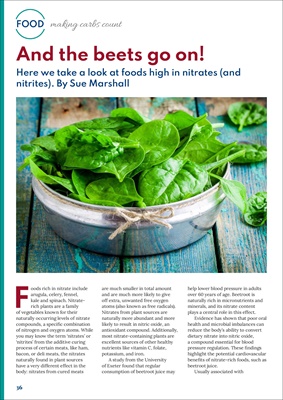
36
making carbs count
FOOD
And the beets go on!
Here we take a look at foods high in nitrates (and
nitrites). By Sue Marshall
Foods rich in nitrate include
arugula, celery, fennel,
kale and spinach. Nitraterich plants
are a family
of vegetables known for their
naturally occurring levels of nitrate
compounds, a specific combination
of nitrogen and oxygen atoms. While
you may know the term 'nitrates' or
'nitrites' from the additive curing
process of certain meats, like ham,
bacon, or deli meats, the nitrates
naturally found in plant sources
have a very different effect in the
body: nitrates from cured meats
are much smaller in total amount
and are much more likely to give
off extra, unwanted free oxygen
atoms (also known as free radicals).
Nitrates from plant sources are
naturally more abundant and more
likely to result in nitric oxide, an
antioxidant compound. Additionally,
most nitrate-containing plants are
excellent sources of other healthy
nutrients like vitamin C, folate,
potassium, and iron.
A study from the University
of Exeter found that regular
consumption of beetroot juice may
help lower blood pressure in adults
over 60 years of age. Beetroot is
naturally rich in micronutrients and
minerals, and its nitrate content
plays a central role in this effect.
Evidence has shown that poor oral
health and microbial imbalances can
reduce the body's ability to convert
dietary nitrate into nitric oxide,
a compound essential for blood
pressure regulation. These findings
highlight the potential cardiovascular
benefits of nitrate-rich foods, such as
beetroot juice.
Usually associated with